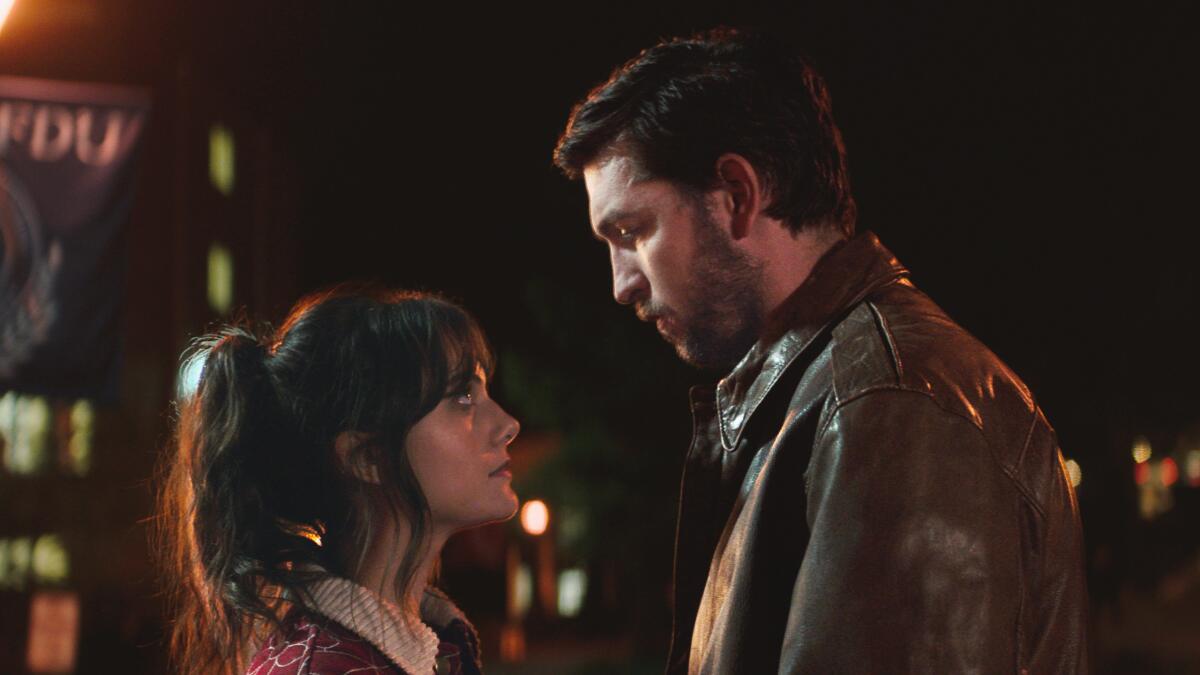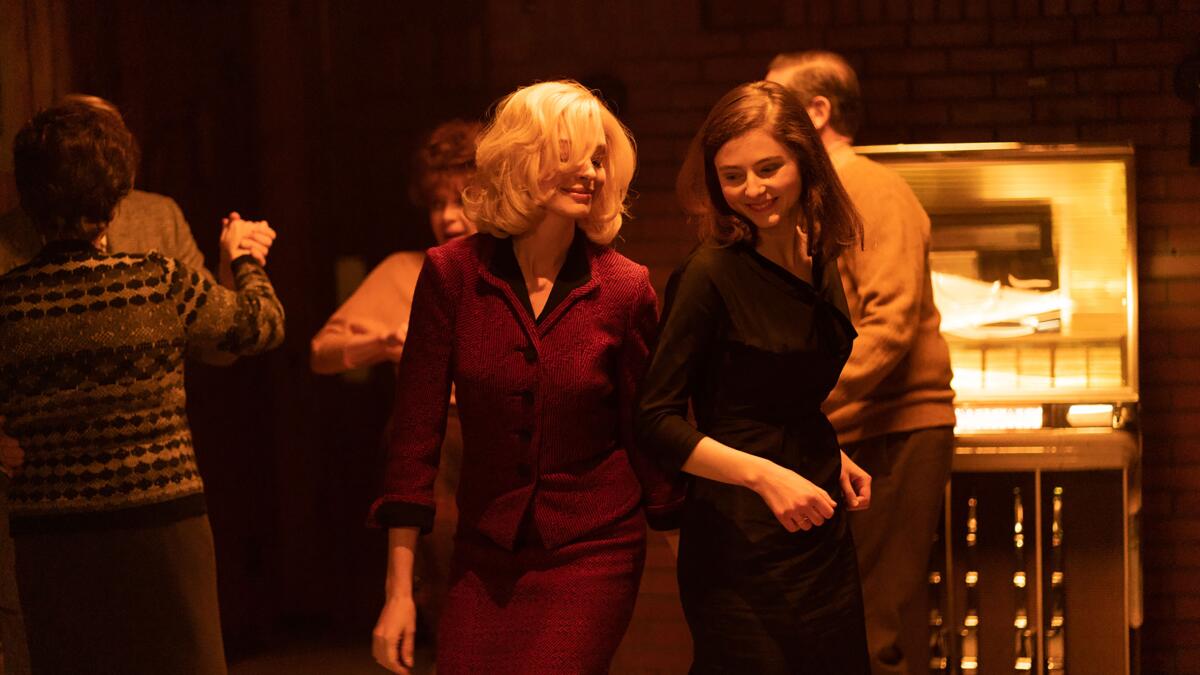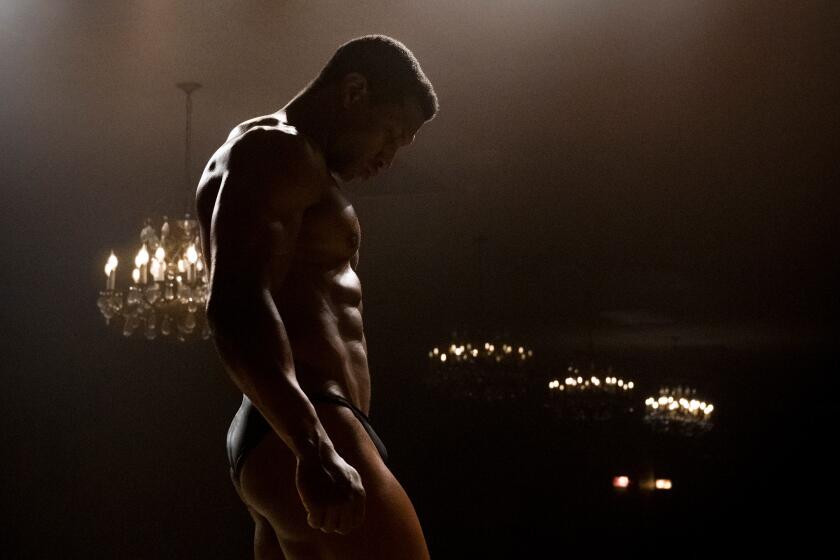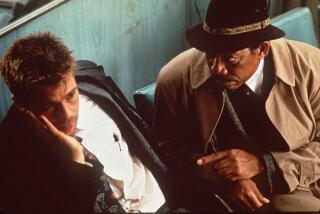Sundance: As ‘Cat Person’ ruins a viral sensation, ‘Eileen’ makes a stir of its own

- Share via
PARK CITY, Utah — Late into “Cat Person,” the much-buzzed-about new movie adapted from Kristen Roupenian’s 2017 short story of the same title, an ugly one-word text message appears in startling, screen-filling closeup. You’ll know what the word is if you’ve read the story, and there’s a decent chance you have, since it is one of the more widely circulated and ferociously debated fiction pieces published by the New Yorker in recent memory.
Still, to judge by the gasps that greeted that word at the movie’s Sundance Film Festival premiere Saturday night, there were clearly many in the audience who hadn’t. Presumably they were also unaware that the word is also the very last word of Roupenian’s story, which, unlike the movie, does not proceed to devolve into a bloody, fiery and spectacularly violent mess.
Don’t worry, I haven’t just ruined “Cat Person” for you. In some ways it would be fitting if I did, since the movie, directed by Susanna Fogel (“The Spy Who Dumped Me”) from a script by Michelle Ashford, more or less ruins the story. I’m not a purist when it comes to adaptations; my general rule of thumb is that the more irreverent liberties a movie takes with its source material, the better. But there is nothing better about this “Cat Person,” which coarsens, flattens and torturously over-elaborates a story whose elegant concision was precisely what made it such rich and elastic interpretive fodder.
Was Roupenian’s yarn an intensely relatable account of an ill-advised romance, or a slippery consideration of the shifting power differential between an older man and a younger woman? A cautionary tale about the perils of modern dating, the devilishness of technology or the ambiguity of consent? A spot-on encapsulation of a woman’s point of view or a mean-spirited exercise in fat-shaming?
The filmmakers have at least attempted to preempt the latter charge: Robert, portly on the page, is played here by the very tall and lanky Nicholas Braun (“Succession”), who otherwise projects the character’s requisite weird mix of curtness and sensitivity, sweetness and schlubbiness.
Those qualities are what strangely endear him to Margot (Emilia Jones), a 20-year-old college student who works at the concession stand of a movie theater that Robert visits often. And so begins (and soon ends) a relationship that — advancing swiftly from long, lively text chains to an awkward date and a night of epically bad sex, at least for Margot — serves as a timely reminder of the sometimes yawning chasm between who we think we might be dating and who they really are.
Film critic Justin Chang examines two Sundance films that draw blood: Chloe Domont’s ‘Fair Play’ and Jonathan Majors vehicle ‘Magazine Dreams.’

All that is on the screen, more or less, plus Harrison Ford references, a scary dog, several obtuse fantasy/hallucination sequences and some deliciously blunt commentary on insect mating habits provided by a professor (Isabella Rossellini) whom I immediately wanted to follow into a movie of her own (“Ant Person,” naturally). Geraldine Viswanathan (“Blockers”) is also very good as the opinionated bestie who notes early and often that this relationship is clearly not very good, and who is no less annoying for being absolutely correct.
All in all, you can’t fault the actors in “Cat Person,” least of all Jones, who’s entirely believable and empathetic here as a young woman who can be both cutting and vulnerable, cynical and naive. (The most amusing way to approach “Cat Person” is to see it as a parallel-universe sequel to Jones’ off-to-college arc in “CODA.”)
But you can easily fault some of Fogel and Ashford’s more bludgeoning storytelling choices, including the ways they’ve chosen to visualize their heroine’s active fantasy life. Again and again, and in ways that are neither as creepy nor as funny as intended, Margot imagines the worst-case scenario (i.e., Robert lunging violently at her in a locked darkroom) long before the actual worst-case scenario kicks in.
The movie is far better when it simply allows her fears to play out, without any cutesy comic annotation: The scene in which Robert kisses Margot for seemingly minutes on end, his lips sucking away somewhere in the vicinity of her mouth and nose, is one of the few where you can see what this “Cat Person” might have been in more cinematically confident hands.
Far clunkier is the inevitable bad-sex scene, a kind of out-of-body experience in which Margot and her own eye-rolling double narrate what’s being done to her in real time, moment by awful, cringe-inducing moment. In that sequence and others, “Cat Person” labors to open up material that simply doesn’t want to be opened up — that thrives on a level of subjectivity, and on a sustained ambiguity of intent and detail, that the movies have always been hard-pressed to replicate.
None of which is to suggest that Roupenian’s story is unfilmable, only that it hasn’t been well filmed. As hot properties go, the story has clearly been seized upon for its title recognition and viral cachet, but also with seemingly minimal consideration of why it cried out to be made into a movie — let alone the violent genre movie into which it abruptly swerves in its final act.
The first in-person Sundance since 2020 is about to begin. Our critic has some early recommendations, including ‘The Eternal Memory’ and ‘Mami Wata.’

Is this swerve meant to boost “Cat Person’s” commercial prospects in an industry where horror is one of the few genres that can still reliably turn a profit? Or to literalize the notion that, duh, relationships can be scary?
If so, a much more effective demonstration of that principle could be found in William Oldroyd’s nastily unpredictable “Eileen,” which premiered immediately before “Cat Person,” at the same venue, for reasons that I can only suspect gave the festival programmers a chuckle. For “Eileen” — although set in snowy 1964 Massachusetts and centered on the bond that forms between two women — is also very much about the seductiveness of appearances and the thrill and disappointment of new relationships. And no less than “Cat Person,” it’s a portrait of a young woman negotiating complex, often contradictory feelings and often envisioning the most violent outcome to any situation.
Feelings of any kind, beyond everyday depression and anger, seem awfully scarce in the community where the sad-eyed, sexually frustrated Eileen (a superb Thomasin McKenzie) lives with her hard-drinking lout of a father (Shea Whigham) and works in a boys’ prison. It’s there that she strikes up a rapport with the prison’s new psychologist, Rebecca (Anne Hathaway, stunning), whose impossible sophistication and glamour stand out in these dreary surroundings, and who upon arrival immediately fixes Eileen with a conspiratorial smile. As Rebecca takes Eileen under wing, talking shop and taking her out for drinks and dancing, you might find yourself wondering if you’re watching Oldroyd’s version of “Carol” — not just because of the intimations of lesbian desire, but also because of the unmistakable Patricia Highsmithian vibes at work. And then the story makes its sudden, harrowing shift into — well, to say more about that would be unfair.
But speaking of unfair: Does “Eileen” benefit from the fact that I haven’t read the 2015 Ottessa Moshfegh novel on which it’s based, unlike “Cat Person,” which was adapted from a short and endlessly scrutinized story that I had read in advance? How much of this has to do with filmmaking, good or bad, and how much of it has to do with one’s own expectations?
It’s a fair question, though I suspect that even had I known every “Eileen” plot beat in advance, I would still have been held by Oldroyd’s directorial control (as evident here as in “Lady Macbeth”), by the movie’s chilly New England atmosphere and faultless ’60s production design, and especially by Hathaway’s silky poise and McKenzie’s roiling mischief. Certainly I would have been held by Marin Ireland’s startlingly raw performance as a woman who reminds you — in ways that other movies could stand to learn — that there is in fact always more to the story, and that more is often terrifying.
More to Read
Only good movies
Get the Indie Focus newsletter, Mark Olsen's weekly guide to the world of cinema.
You may occasionally receive promotional content from the Los Angeles Times.













